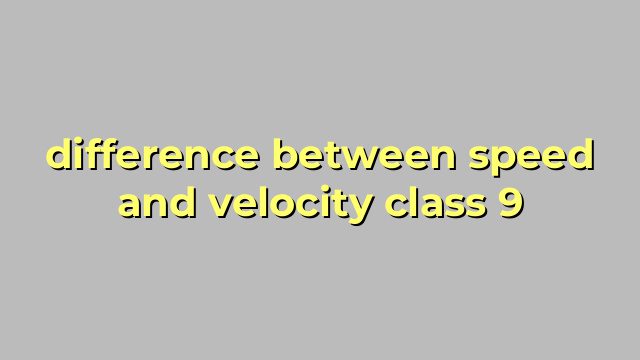The Difference Between Speed and Velocity Explained for Class 9 Students
When we talk about motion, we often use terms like speed and velocity interchangeably. However, these two terms have distinct meanings that are important to understand. In this article, we’ll explain the difference between speed and velocity and why it’s important to use them correctly.
What Is Speed?
Speed is a measure of how fast an object is moving, regardless of its direction. It is a scalar quantity, which means it only has a magnitude (size) and no direction. So, speed is the distance an object travels per unit time.
For example, if a car travels 60 km in 1 hour, we can say that the speed of the car is 60 km/h. It means that the car is traveling at a rate of 60 kilometers per hour.
What Is Velocity?
Velocity is also a measure of how fast an object is moving, but it includes the direction of motion. It is a vector quantity because it has both magnitude and direction. So, velocity is the distance an object travels per unit time in a specific direction.
For example, if a car travels 60 km north in 1 hour, we can say that the velocity of the car is 60 km/h north. It means that the car is traveling at a rate of 60 kilometers per hour, and its direction of motion is north.
Why Is It Important to Understand the Difference?
Understanding the difference between speed and velocity is crucial because they have different applications, and using them incorrectly can lead to confusion or errors. For example, if we are talking about the motion of a projectile, such as a ball thrown into the air, we need to use velocity to determine its position, speed, and direction.
Moreover, velocity is essential in physics and engineering as it helps us understand and predict the behavior of objects in motion. By knowing the velocity of an object, we can calculate its acceleration, momentum, and other physical properties that help us analyze its motion.
In conclusion, speed and velocity are both measures of how fast an object is moving, but velocity includes the direction of motion, making it a vector quantity. Understanding the difference between the two terms is vital in physics, engineering, and everyday life as it helps us make more accurate calculations and predictions.
Table difference between speed and velocity class 9
| Speed | Velocity | |
|---|---|---|
| Definition | Speed is the measure of how fast an object is moving, without taking direction into consideration. | Velocity is the measure of how fast an object is moving in a specific direction. |
| Formula | Speed = Distance / Time | Velocity = Displacement / Time |
| Unit of measurement | The SI unit of speed is meter per second (m/s). | The SI unit of velocity is also meter per second (m/s), but it also includes the direction of motion. |
| Positive and negative values | Speed can only have positive values. | Velocity can have positive or negative values, depending on the direction of motion. |
| Examples | A car moving at a speed of 60 km/h | A car moving at a velocity of 60 km/h west |

